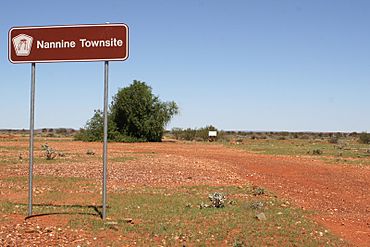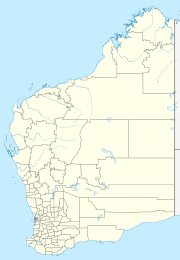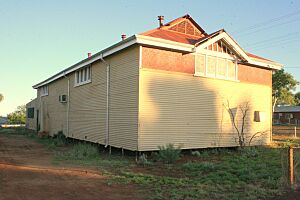Nannine, Western Australia facts for kids
Quick facts for kids NannineWestern Australia |
|
|---|---|

Nannine Townsite 2008
|
|
| Established | 1893 |
| Postcode(s) | 6642 |
| Elevation | 452 m (1,483 ft) |
| Location |
|
| LGA(s) | Shire of Meekatharra |
| State electorate(s) | North West |
| Federal Division(s) | Durack |
Nannine is a ghost town in the Mid West part of Western Australia. A ghost town is a place where people used to live and work, but now it's mostly empty. Nannine is located on the northern side of Lake Anneen. It's about 35 kilometres (22 miles) south-southwest of Meekatharra. It's also about 735 kilometres (457 miles) north-northeast of Perth, the capital city.
Nannine was once a busy gold mining town. It was the first place where gold was found in the Murchison Goldfield. A prospector named John Connelly found gold near Annean Station in 1890. This discovery started a "gold rush," where many people came looking for gold. The Murchison Goldfield was officially declared in September 1891. The town of Nannine was officially created, or "gazetted," in 1893. It was the very first town in that region.
By 1894, Nannine was big enough to have its own electoral district. This meant it had its own representative in the government. In 1896, work began on a railway line connecting Nannine to Cue, Western Australia. This railway was finished in 1903. The line was later extended to Meekatharra starting in 1909.
History of Nannine
The name Nannine comes from an Aboriginal word. "Nannine Wells" was first written down by a surveyor in 1889. The name means 'fat'. It refers to a place in the Aboriginal landscape where a Dingo from the Dreamtime (a spiritual time) bit off part of an Emu. This left a mark on a local cliff-face, which Aboriginal people called 'nganiny'.
Gold Discovery
The first gold discoveries in Nannine are a bit unclear. However, it seems that two station workers, Ingpen and Watts, first suspected gold in May 1890. They showed the site to J. F. Connolly, a mining engineer. Connolly found gold, but he didn't seem very impressed. Later, in October 1890, McPherson and Peterkin were led to the same spot. They found a lot of gold. By August 1891, these prospectors and others had found about 1,700 ounces (48 kilograms) of gold. The Murchison Goldfield, which included Nannine, was officially declared in September 1891. By December, about 700 men were working in the goldfield.
Town Development
The first settlement was in a gully area. In 1892, John Forrest, who was in charge of Crown Lands, decided to survey land and create an official townsite. He first called the place "Annean," after the nearby station. When miners heard that land lots would be sold in Perth, 85 of them asked Forrest to hold the auction in Geraldton instead. The land was surveyed in August 1892. The town was named Nannine because it was near Nannine Wells and was the name of the proposed electoral district. The townsite was officially created in April 1893. After the official town was set up, many businesses moved from the old settlement to the new, official townsite. This move was mostly finished by 1896 or 1897.
Weather Challenges
In 1913, the town and surrounding area had very heavy rains. Nannine received 46 millimetres (1.82 inches) of rain in one day. This caused the railway line to Meekatharra to flood. It also created a large washaway (a place where water washed away the ground) a few miles north of town. By 1919, the town was starting to decline.
Town Services
Water Supply
In November 1906, the town's water supply system was officially opened. This was important for the people living there.
Mining Warden's Court
By 1893, the Wardens Court was still just a tent. A Warden was a government official who dealt with mining laws and disputes. Luckily, construction began on a stone building for the Warden's Court and Registrars office in March 1896. W. A. G. Walters was the first mining Warden at Nannine. He arrived in September 1891.
Police and Law
A Police Station was built in 1896 to keep order in the town. The station closed in January 1922. The building was then moved to Yalgoo later that year. Constable Binnings was in the area by September 1891. He was specifically in Nannine by April 1892.
Education for Children
The Reverend Gilbert Harding opened a school next to his home in March 1906. This school was helpful for parents with children who lived in areas without a school. It also provided boarding for students who needed to stay there.
Transport and Travel
In January 1892, Spalding started a coach service from Mingenew to Annean. Marsh also ran a coach service from Geraldton to Nannine starting in July of the same year. By 1897, Gascard coaches ran twice a week from Yalgoo. The railway line from Cue to Nannine officially opened on January 6, 1903.
Mail and Communication
A telegraph line to Geraldton began service in November 1894. This allowed people to send messages quickly. Work on a stone post and telegraph building started in March 1896. It was located at the corner of Marmion and McPherson Streets. A. C. Twine was listed as the Postmaster in 1897.
Hotels and Businesses
Nannine had many hotels and businesses to serve the miners and residents.
Hotels
In the early days, there were several hotels. Dan Downie opened one of the first in January 1892. Other early hotels included the Royal, the Excelsior, the Murchison, and the Nannine. Mrs. Ramsay, who ran the Murchison, was the first woman at the goldfield.
When the official townsite was created, businesses moved. The Pioneer Hotel, run by Downie, was one of four hotels still open in 1898. The Royal Hotel was also trading in December 1909. The Victoria Hotel and the Victory Hotel were also present. Judge's Hotel on Simpson Street was the largest building in town around 1896-1897. The Nannine Hotel was a large building with many rooms and a billiard room. In 1907, there was an explosion of a gasometer (a gas storage tank) at the Nannine Hotel, which blew the roof off an outhouse. The manager, Eleanor Willows, was not hurt. The North Murchison was one of the last hotels, closing in the 1940s.
Other Businesses
The town had many different types of businesses to support the community. In the early settlement, there were small shops and butchers. When the official town was established, more businesses opened. These included bakers, blacksmiths, builders, and butchers. There was even a cool drink factory and hairdressers. Some people ran market gardens to grow fresh food. Mining agents helped people with their mining claims. There were also general stores, newsagents, photographers, and stonemasons. These businesses show how Nannine grew into a busy town during the gold rush.
Community Buildings
Miners Institute
A timber and iron building called the Miners Institute was built in 1896. This was a community hall for miners. It was later handed over to the Municipal Council to manage in 1910. The only church building in town at that time was a Roman Catholic church.
The Masonic Hall
Freemasonry was a social group that was important in many towns in Australia during the early 1900s. The Masonic Hall was first built in Nannine around 1900. When Nannine started to decline about 20 years later, the building was moved to Meekatharra. The Heritage Council of WA describes the building's style as "Federation Gothic." It was used for social and civic activities. Today, the Hall stands in Meekatharra. It is a reminder of the past, showing how buildings from ghost towns can sometimes find new life elsewhere.



